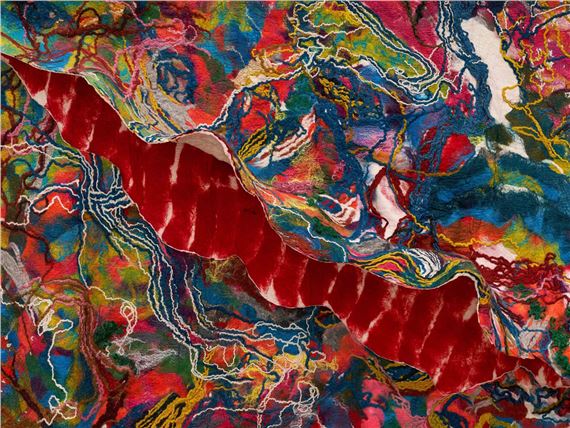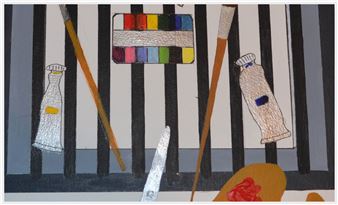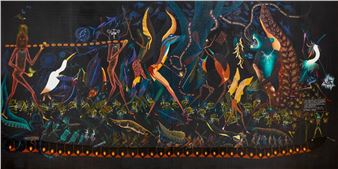Sagarika Sundaram: Release
Alison Jacques presents вҖҳReleaseвҖҷ, the first UK exhibition of new work by Sagarika Sundaram (b.1986, Kolkata, India; lives and works in New York). Working primarily with raw natural fibres, SundaramвҖҷs intuitive practice of вҖҳpainterly sculptureвҖҷ or вҖҳtextile paintingвҖҷ defies material, spatial, and linguistic boundaries. This new body of work deepens her connection to fibre and felt; nuanced in colour and complex in form, she sculpts space as well as material, incorporating felt reliefs and glass mosaics, as well as a large-scale installation. This exhibition anticipates SundaramвҖҷs forthcoming solo show, curated by Laurence Sillars, at the Henry Moore Institute, Leeds, in 2026.
вҖҳReleaseвҖҷ alludes to an aliveness in SundaramвҖҷs practice. Born out of the internal space in the body that gives rise to breath or laughter, and driven by a kind of letting go, her works take shape through embedded pockets that are cut open in a single, irreversible gesture, releasing form from within. The exhibition showcases new avenues of expression, including the exploration of glass to create wall-based sculpture. A constant across SundaramвҖҷs experimentation is her interest in colour, as she describes: вҖҳthereвҖҷs an alchemy to itвҖҷ. This colourful вҖҳalchemyвҖҷ is both precise and playful, as she told Vogue IndiaвҖҷs Radhika Iyengar, вҖҳa true test of a dyer is not whether you can make colour, but if you can make the same colour twice.вҖҷ
A large-scale installation, suspended in the galleryвҖҷs naturally lit back space, is cut from one piece of cloth. The work transforms its environment, energising the spatial void with material encircling a central axis. Across the exhibition, works reference the mandala: a holistic concept integrating the body with itself, grounded in a flat geometric design, and structured around one central point. In its multidimensional activation through space вҖ“ from wall relief to suspended sculpture вҖ“ Sundaram breaks open this traditional symbol. As she observes: вҖҳwith each new work, I develop new pathways.вҖҷ Informed by the modern dancer ChandralekhaвҖҷs (1928-2006) interpretation of movement, artist Mrinalini MukherjeeвҖҷs (1949-2015) natural fibre sculptures, and Anish KapoorвҖҷs (b.1954) large-scale investigation of matter and non-matter, SundaramвҖҷs artwork choreographs the dynamic between the individual and the gallery space.
At age 11, while Sundaram was a student in Andhra Pradesh, India, she experimented with textiles for the first time, specifically batik вҖ“ a wax-resist technique. Two decades later, in London, Sundaram made her first felt work, cleaving it open with a knife, later describing this process as вҖҳcutting it open felt like discovering a secret insideвҖҷ. In her studio, Sundaram transforms wool into felt through an organic process that involves a physical, embodied performance of dyeing, tearing, and compressing raw fibre. She handles material as if sketching, layering fibres like cross-hatching to make a mesh. Soaking her composition in soapy water, Sundaram then applies pressure to fuse the fibre into its final form. вҖҳBy the time things are humming along, the ending makes itself obviousвҖҷ, she describes. вҖҳThe work is complete when I can feel it talking to me.вҖҷ

Recommended for you
Alison Jacques presents вҖҳReleaseвҖҷ, the first UK exhibition of new work by Sagarika Sundaram (b.1986, Kolkata, India; lives and works in New York). Working primarily with raw natural fibres, SundaramвҖҷs intuitive practice of вҖҳpainterly sculptureвҖҷ or вҖҳtextile paintingвҖҷ defies material, spatial, and linguistic boundaries. This new body of work deepens her connection to fibre and felt; nuanced in colour and complex in form, she sculpts space as well as material, incorporating felt reliefs and glass mosaics, as well as a large-scale installation. This exhibition anticipates SundaramвҖҷs forthcoming solo show, curated by Laurence Sillars, at the Henry Moore Institute, Leeds, in 2026.
вҖҳReleaseвҖҷ alludes to an aliveness in SundaramвҖҷs practice. Born out of the internal space in the body that gives rise to breath or laughter, and driven by a kind of letting go, her works take shape through embedded pockets that are cut open in a single, irreversible gesture, releasing form from within. The exhibition showcases new avenues of expression, including the exploration of glass to create wall-based sculpture. A constant across SundaramвҖҷs experimentation is her interest in colour, as she describes: вҖҳthereвҖҷs an alchemy to itвҖҷ. This colourful вҖҳalchemyвҖҷ is both precise and playful, as she told Vogue IndiaвҖҷs Radhika Iyengar, вҖҳa true test of a dyer is not whether you can make colour, but if you can make the same colour twice.вҖҷ
A large-scale installation, suspended in the galleryвҖҷs naturally lit back space, is cut from one piece of cloth. The work transforms its environment, energising the spatial void with material encircling a central axis. Across the exhibition, works reference the mandala: a holistic concept integrating the body with itself, grounded in a flat geometric design, and structured around one central point. In its multidimensional activation through space вҖ“ from wall relief to suspended sculpture вҖ“ Sundaram breaks open this traditional symbol. As she observes: вҖҳwith each new work, I develop new pathways.вҖҷ Informed by the modern dancer ChandralekhaвҖҷs (1928-2006) interpretation of movement, artist Mrinalini MukherjeeвҖҷs (1949-2015) natural fibre sculptures, and Anish KapoorвҖҷs (b.1954) large-scale investigation of matter and non-matter, SundaramвҖҷs artwork choreographs the dynamic between the individual and the gallery space.
At age 11, while Sundaram was a student in Andhra Pradesh, India, she experimented with textiles for the first time, specifically batik вҖ“ a wax-resist technique. Two decades later, in London, Sundaram made her first felt work, cleaving it open with a knife, later describing this process as вҖҳcutting it open felt like discovering a secret insideвҖҷ. In her studio, Sundaram transforms wool into felt through an organic process that involves a physical, embodied performance of dyeing, tearing, and compressing raw fibre. She handles material as if sketching, layering fibres like cross-hatching to make a mesh. Soaking her composition in soapy water, Sundaram then applies pressure to fuse the fibre into its final form. вҖҳBy the time things are humming along, the ending makes itself obviousвҖҷ, she describes. вҖҳThe work is complete when I can feel it talking to me.вҖҷ
Artists on show
Related articles
Sandwiching together wool and felt before splicing them into colourful life, as Sundaram explains: it all started with her grandmotherвҖҷs sari.

 ARTISTS
ARTISTS












